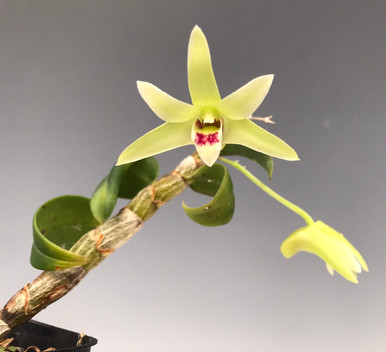Section Phalaenanthe & Spatulata Dendrobium Orchid Care
Naturally occurring across the Indopacific and Australasia, Dendrobiums species and hybrids of the sections Spatulata and Phalaenanthe have become some of the most readily available in the horticultural trade. The iconic Phalaenopsis-type Dendrobiums derived from Den. biggibum and the miniaturized Antelope Dendrobiums with their characteristic curling ‘horns’ are now common even at large department stores. Species and hybrids in these sections are known for their long sprays of brightly colored flowers which appear annually and can last for months at a time. These Dendrobiums can bloom repetitively over several years from the same mature canes. Many of the natural species, particularly in the section Spatulata, can reach impressive sizes, with upright canes that stretch over six feet in length. Meanwhile, derivative hybrids typically range in height from six inches to three feet. Phalaenanthe and Spatulata Dendrobiums are typically hardy, vigorous growers which are well-suited for beginner orchid growers. Common species include Den. antennatum, Den. biggibum (syn. phalaenopsis), Den. canaliculatum, Den. gouldii, Den. lasianthera, Den. stratiotes, and Den. tangerinum.
Light and Shade
Spatulata and Phalaenanthe Dendrobiums grow well under bright light. Filtered light from south- or east-facing windows will suit plants of this section well. Direct morning sunlight for short periods of time will not harm these Dendrobiums, but long exposure periods in early Spring or during the afternoon should be avoided.
Temperature and Humidity
Variable from warm to hot, depending on the species and hybrid. Dendrobiums in these sections will grow best at warmer temperatures (65-85F) year-round. Do not expose them to temperatures below 60F. These Dendrobiums will grow well with a relative humidity of 50% to 75% accompanied by good airflow year-round.
Watering & Feeding
Species and hybrids in this section should be watered regularly and allowed to almost completely dry out between waterings during their active season of growth. During this time period, fertilizer should be applied regularly since Spatulata and Phalaenanthe Dendrobiums are vigorous, hungry growers. Some tropical Antelope Dendrobium species such as Den. antennatum and related hybrids do not need a reduction in watering during winter months, but care should be taken not to overwater plants when they are not in active growth. Phalaenopsis-type Phalaenanthe Dendrobiums such as Den. biggibum and its related hybrids should receive reduced watering and a hiatus from fertilizer once active growth has tapered off in the fall, resuming again once new growths begin to emerge the following spring.
Potting
Dendrobiums of these sections can be grown in a medium to large bark-based mix, coconut husk, or New Zealand sphagnum moss in well-draining containers. Clay pots are often a good choice for Dendrobiums in these sections because they can quickly become top-heavy in containers made from lighter materials. They prefer to be under-potted in similar fashion to other Dendrobiums. It is best to wait to repot these plants until new growths and accompanying roots have begun to emerge, unless an emergency dictates otherwise. Do not re-pot Phalaenanthe and Spatulata Dendrobiums when the plants are not in a period of active growth.
Pest Control
The main pest that Dendrobium attract are mealybugs, which will hide in the axis where the leaf meets the cane. The best treatment for mealybug is either a homemade pesticide of 1:1 parts water & rubbing alcohol, with a few drops of dish soap added. Spray the plants every few days, washing off the dead bugs in between. For large outbreaks, an application of a specially formulated pesticide spray every few days is more effective.
Featured Products
Shop all →




